"A new illustrated lecture filmed on an amusing trip by bicycle through the isolated, unspoiled southwestern corner of Colorado." Pacific Union Recorder, Dec. 12, 1949, 4.
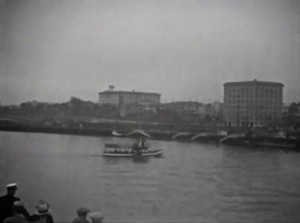
"Footage of various places in Southern California and Mexico." Archive.org
"Shows Don and Phyllis Munday family travelling from Vancouver to Prince Rupert on the S.S. 'Cardena', including a long stop at Bella Coola, and climb up Mount Saugstad" British Columbia Archives.
"Filmed by John C. Jay, Jr., ACL, of Williams College, Skis Over Skoki was shown recently at the Eleventh Annual Show of Amateur Motion Pictures, sponsored by Duncan MacD. Little, ACL. Mr. Jay's film, which is 400 feet of 16mm. Kodachrome, accompanied by sound on disc, was made for the Canadian Pacific Railway and will be shown by them to major ski clubs throughout the country. The film outlines a short story of a girl who, having grown bored with the usual mountain trails, leaves her guide during one of the downhill runs and starts over treacherous territory alone. How she ends her journey and what happens en route are shown by Mr. Jay in some of his finest pictures of skiing, a field in which he is an expert. He has made several films of skiing in the past" Movie Makers, June, 1940, 279.
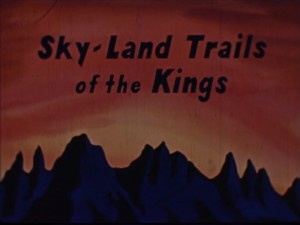
Subtitled: a story of happy days in Kings Canyon National Park.
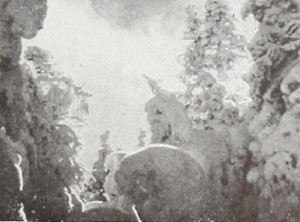
"Robert P. Kehoe accepted a strong challenge and secured a fine result in filming Snow on the Mountains. Filming so static a subject as snow forms, iced trees and wind storms on a mountain presents a real task of vitalizing the material. Mr. Kehoe has brought weird and beautiful life to the screen. This film, excellently scored to present the musical message suggested by the snow scenes, builds from the pleasantness of subdued ice and snow forms, through the almost animate figures created by winter on trees and bushes, to a breath taking climax of a snow storm on the mountain. Culminating the beautifully edited and intelligently filmed footage is an inspiring sequence of flaming powdered snow, reflecting the full crimson of the sunset. So remarkable is this action that the impression imparted is almost one of a cascade of liquid fire flowing across the screen. In order to secure many of the scenes, Mr. Kehoe stood so long in the snow that it was necessary actually to lift him into a motor car and to remove the cine equipment from his chilled hands at the end of his task." Movie Makers, Dec. 1944, 494.
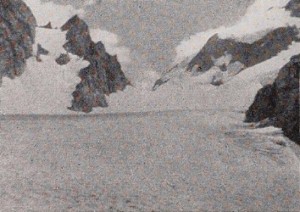
"The Blue refers to a glacier of majestic proportions high in the Olympic Mountains of northern Washington. Solduc, a small station in the Hoh Valley, is the point from which Theodore H. Sarchin and his two companions set out with high hopes to conquer the formidable ascent to the famous ice fields. Although they reach the Blue, the sun has been there first, softening the ice, and they must turn back without having attained the summit. Inherent in the film is a deep reverence for the wild, inspiring beauty of the scene, which clearly communicates itself to the audience — no small achievement in an amateur travel study. This reverence never becomes mawkish, the pedestrian titles and homely incidents en route nicely counterbalancing it. Superior camera work makes the most of the setting, while skillful editing combined the best elements of story and scene to make a dramatic presentation. An expertly scored musical accompaniment adds impressively to enjoyment of Solduc To The Blue." Movie Makers, Dec. 1948, 492.
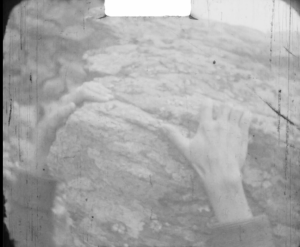
Fiction film that can be inscribed in the tradition of the “mountain films” that were relatively popular at the time in Europe. It is one of the best filmed fiction films of the amateur movement, with interesting camera movements.
"Telemark, filmed in the Swiss Alps by William G. McKelvy, ACL, is, as its name suggests, a skiing picture. However, it is more than that — it is also a very delightful and neatly plotted comedy that is the more convincing for being uncomplicated with the usual subsidiary plot and counter plot. Four or five youths who are expert skiers, one who is a novice, and a girl are at the beginning of a down mountain ski trail. The girl offers a kiss to the boy who can catch her. She tarts off, the able skiers follow hard on her trail, while the beginner stumbles and lags far behind. But the girl decides to trick her pursuers and hides on the way. The ending is obvious. The picture was exquisitely planned and sequenced for, as the camera follows the skiers down the mountain, there is complete smoothness in the shift of viewpoints. The action is made the occasion of splendid studies, as the boys on the run swerve and turn in stems, Christianias and Telemarks. Mr. McKelvy did not neglect to select charming compositions and to take full advantage of clear air and the contrast between the dark figures and trees and the white snow." Movie Makers, Dec. 1933, 500.
Total Pages: 8